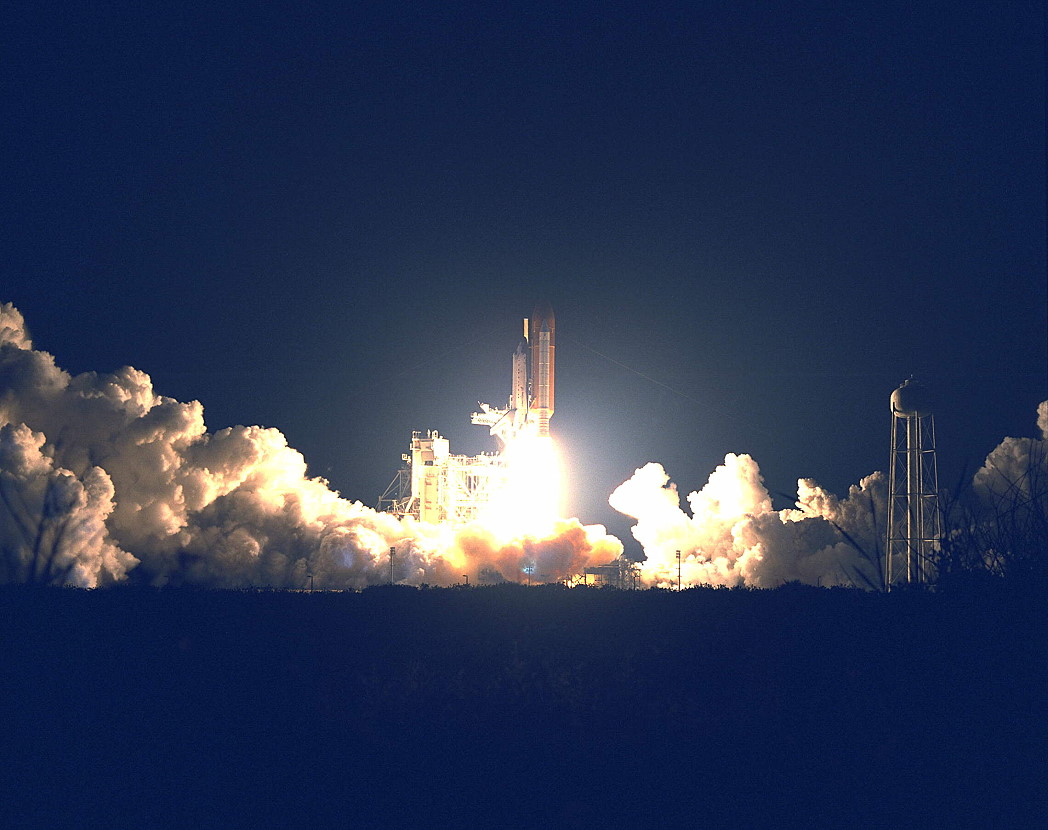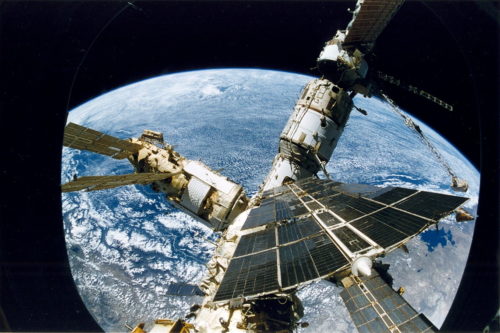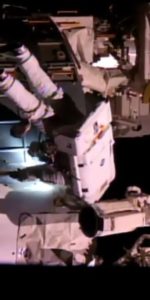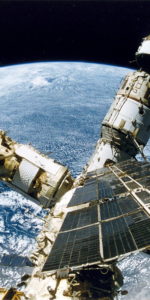
Twenty years ago, this week, Space Shuttle Atlantis roared into the night, creating a new dawn across the marshy landscape of the Kennedy Space Center (KSC). “We just lit up the sky, all the way up and down the Florida coast,” STS-84 Pilot Eileen Collins remembered, then added: “So we’re told!” The launch of Collins and her six crewmates—with a heritage of no fewer than six sovereign nations—from Pad 39A occurred at 4:07 a.m. EDT on 15 May 1997, kicking off an ambitious nine-day mission to rendezvous, dock and exchange astronauts and supplies aboard Russia’s Mir space station.
At times, the blaze of fire and bright flashes were so intense that Collins was reluctant to look outside her cockpit window, lest they interrupt her vision. In the words of STS-84 Commander Charlie Precourt, the crystal clarity and near-perfect weather conditions meant that Atlantis’ ascent was visible to ground-based observers almost as far as Main Engine Cutoff (MECO), some eight minutes into the flight.
When Precourt was assigned to lead STS-84 in February 1996, it soon became clear that he would be the first U.S. astronaut to fly to the Russian station on two occasions, having previously piloted the first shuttle-Mir docking mission. Several months later, in July and August, the seven-strong crew was rounded out with perhaps the most “international” flavor of any shuttle flight. In addition to Eileen Collins, five Mission Specialists—Russia’s Yelena Kondakova, Peru-born Carlos Noriega, Frenchman Jean-Francois Clervoy, Chinese-born Ed Lu and British-born Mike Foale—would launch aboard Atlantis. Foale would remain aboard Mir for several months, with fellow NASA astronaut Jerry Linenger due to return to Earth in his place, after four months aboard the station. With representatives of six sovereign nations, STS-84 would eclipse STS-75—which had U.S., Italian, Swiss and Costa Rica-heritage crew members—as the most diverse shuttle crew at that time.
This was fitting, because in addition to its Mir docking commitment, STS-84 carried one of the largest hauls of European research payloads ever carried into space. Overseen by Clervoy, who served as the mission’s “payload commander”, a package of European-supplied Global Positioning System (GPS) sensors and the multi-purpose Biorack facility were housed aboard a Spacehab pressurized laboratory in Atlantis’ payload bay. During the course of the mission, lentil roots, single-celled organisms, white blood cells and bone cells, yeast samples, tadpoles and fish embryos were monitored. Elsewhere, solidification processes in transparent liquid alloys were examined.

Due to the tight schedule needed to achieve their Mir rendezvous, STS-84 had only a seven-minute “window” of time in which to launch on 15 May 1997. In order to accommodate the possibility of technical problems during such a short window, the pre-planned hold in the countdown at T-9 minutes was lengthened from ten minutes to 40 minutes, but Atlantis behaved perfectly. At 4:07:48 a.m. EDT, she sprang from Pad 39A—one of a historic pair of launch complexes, which had seen humanity’s first piloted voyages to the Moon—and flew beautifully into low-Earth orbit. “Maintaining America’s permanent presence in space,” exulted the launch announcer as Atlantis’ 19th mission got underway in spectacular style.
At the time of launch, Mir and its crew of Linenger and Russian cosmonauts Vasili Tsibliyev and Aleksandr Lazutkin were far to the west of Australia. Not for more than an hour was it possible for them to be advised that Atlantis was on its way. “That’s great!” came the excited response from Linenger, whose difficult and troubled four-month increment aboard Mir was entering its homestretch.
With so many nationalities aboard, the astronauts and cosmonauts of STS-84 drew much attention from around the world. During one in-flight news conference, a British journalist asked Precourt if Foale was made of “the right stuff”. Grinning, Foale wagged an accusatory finger at his commander, as if to dare him to say “the right thing”. Ever the diplomat, Precourt—who went on to serve as Chief of the Astronaut Office, later in his career—did not disappoint. “He’s warning me that I’d better say yes to that one,” Precourt replied, adding that Foale was “a great asset to the NASA program”.
Early into the STS-84 mission, Precourt and Collins oversaw a series of phasing and orbit-adjustment “burns” to precisely align the shuttle and Mir. In one comical moment, the onset of one burn caused Precourt’s baseball cap to briefly jump from his head, before he grabbed it back. Elsewhere, their crewmates set up and tested rendezvous rools and Lu installed a centerline camera inside the Orbiter Docking System (ODS). Clervoy opened the hatches into the Spacehab double module, welcoming Kondakova with a hearty “Take a seat” as she followed him with a camera.
At 10:33 p.m. EDT on 17 May, Precourt completed a smooth docking with Mir. “Houston, Atlantis, we have contact and capture,” he announced, as the shuttle achieved a firm metallic embrace with the Docking Module (DM) at the tip of the station’s Kristall module. After customary pressurization and leak checks between the two vehicles, the hatches were opened, allowing Precourt to heartily shake hands with his Russian counterpart, Mir Commander Vasili Tsibliyev, who had been in orbit since the beginning of 1997. In true Russian tradition, Kondakova brought gifts of black bread, salt and tea for Tsibliyev, Lazutkin and Linenger, whilst her crewmates provided STS-84-themed baseball caps and boxes of apples, oranges, chocolates, ice cream and foie gras.
As Foale took his place as a member of the Mir crew, his custom-molded seat was moved into the Soyuz TM-25 spacecraft, which he would use—alongside Tsibliyev and Lazutkin—in the event that an emergency situation demanded an immediate return to Earth. Meanwhile, Linenger’s own seat liner was removed from the Soyuz.
All told, the ten astronauts and cosmonauts spent five days moving 7,300 pounds (3,320 kg) of equipment and supplies between Atlantis and the station. Perhaps the most important transfers were a new gyrodyne and a new Elektron oxygen generator for Mir. An element of urgency came on 17 May, when a pump in support of the single operating Elektron temporarily shut down and put the unit out of action. Although the shuttle’s presence provided more than enough oxygen for both spacecraft during the docked phase, a plan was hurriedly set in motion to get the new Elektron moved over a day earlier.
The new unit was installed into Mir’s Kvant-2 module, whilst a broken Elektron was moved aboard Atlantis for return to Earth. Early plans called for the new Elektron to be installed and tested during the shuttle’s docked phase—which would have required an additional 24 hours and, as a result, a ten-day mission for STS-84—but it was later decided to perform the installation and testing at a later date. As a consequence, Atlantis’ mission retained its baseline configuration as a nine-day flight.
In the weeks after STS-84’s departure, Mir would encounter perhaps the greatest crisis of its 15-year existence.
The second part of this article will appear tomorrow.
Be sure to “LIKE” AmericaSpace on Facebook and follow us on Instagram & Twitter!





